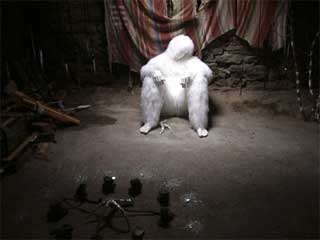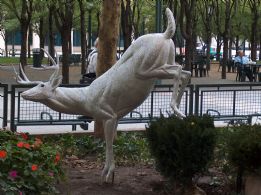Dioramas and models
The diorama is, like its relative the panorama, an eighteenth-century innovation, a pre-cinematic form of entertainment and education intended to provide views of significant places and events. First used in 1821 by Daguerre and Charles Bouton to describe large, hyperrealistic scenes painted on two sides of translucent fabric that produced changing imagery when illuminated. The word diorama stems from the Greek dia (through) and horama (to see).
The Diorama was a popular entertainment that originated in Paris in 1822. An alternative to the also popular "Panorama", the Diorama was viewed by an audience in a highly specialized theatre. As many as 350 patrons would file in to view a landscape painting that would change its appearance both subtly and dramatically. The effect was so subtle and finely rendered that both critics and the public were astounded, believing they were looking at a natural scene.
The inventor and proprietor of the Diorama was Louis Jacques Mande Daguerre , formerly a decorator, manufacturer of mirrors, painter of Panoramas, and a designer and painter of theatrical stage illusions. Daguerre would later co-invent the daguerreotype, the first widely used method of photography.
Daguerre opened a second Diorama in London in 1823.English artists like Clarkson Stanfield produced ever-more elaborate dioramas through the 1830s; sound effects and even living performers were added. Some "typical diorama effects included moonlit nights, winter snow turning into a summer meadow, rainbows after a storm, illuminated fountains," waterfalls, thunder and lightning, and ringing bells.
Painters of the era likeJohn Martin were influenced to create large and highly dramatic pictures by the sensational dioramas and panoramas of their day. On 1 February 1829, Martin's brother Jonathan, known as "Mad Martin," set fire to the roof of the Gothic Cathedral of York Minster. Stanfield created a diorama re-enactment of the event, which premiered on 20 April of the same year; it employed a "safe fire" via chemical reaction as a special effect. The "safe" fire proved to be less safe than planned: it set a real fire in the painted cloths of the imitation fire, which burned down the theater and all of its dioramas.
Nonetheless, dioramas remained popular in England, Scotland, and Ireland through most of the nineteenth century, lasting until 1880.
 Daguerre's Diorama,1823
Daguerre's Diorama,1823
Rick Araluce's work in the Biennial is just one example of a contemporary artist adopting the principles of the diorama as we know it, in the form of created scenes and environments. Her are a few other examples of artists who have created dioramas:



Tony Matelli , Lost & Sick, 1996
Marc Swanson , Killing Moon #3 (self-portrait as Yeti in his lair), Fits and Starts, 2004 (Remember Marc Swanson from Sparkle,Then Fade?)
Michael Ashkin ,#33, 1996 mixed media (252 x 48 in.)
Biennial participant Ross Sawyers builds the scenes that appear in his photographs. Another example of a photographer who creates sets is Julia Fullerton-Batten ,
who then populates her tiny locales with adolescent girls.


Chewing Gum, 2005
C-print
16 x 20 in./ 40.6 x 50.8 cm.
Airport, 2005
C-print
16 x 20 in./ 40.6 x 50.8 cm.
Collaborators Jennifer and Kevin McCoy combine miniature models and scenes with kinetic elements, creating work that explores scale,perspective and viewer perception.
This an installation view of the sculpture,The High Seas, 2007. A video camera and light circle a stationary boat model, moving up and down along a wave guide as they turn. In the projected image, the model looks like it is tossing and pitching on stormy seas.
VIdeo of this project can be found at:
www.mccoyspace.com/video/High_Seas.mov
Staff Pick
As you can guess from the title, this is a little section devoted to an art-related something chosen by a TAM staff member using the following criteria:Favorite artists or individual artwork, an exhibition,museum or gallery that you especially enjoy...Perhaps a book, magazine or website you think deserves to be shared.
The first Staff Pick is from our Mr. Jonathan Smith.
Jonathan picked artist Keith Haring 1958 1990
Of Haring's work Jonathan says,
"His art was relevant to the times," and he appreciates"his (Haring's) ability to depict many human conditions through pop art."
The Keith Haring Foundation
The mission of the Keith Haring Foundation is to sustain, expand, and protect the legacy of Keith Haring, his art, and his ideals. The Foundation supports not-for-profit organizations that assist children, as well as organizations involved in education, research and care related to AIDS.
Here's a link to some very fun Keith Haring screensavers:
http://www.haring.com/extras/screensavers/index.html



Untitled, 1978
Felt-tip Pen and Pencil on Paper
10 x 8 inches
25.4 x 20.3 cm
Untitled, 1989
acrylic on canvas
40 x 40 inches
101.6 x 101.6 cm
Dimensions not given
That's all for this week,
Ellen
 Daguerre's Diorama,1823
Daguerre's Diorama,1823 








